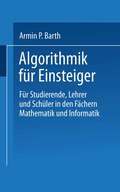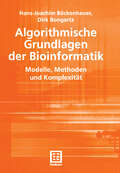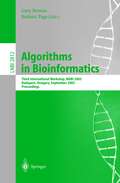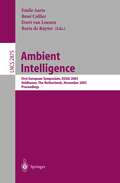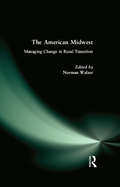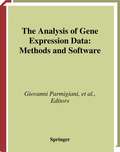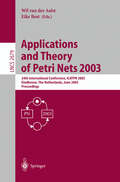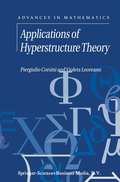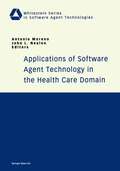- Table View
- List View
Algorithmic Topology and Classification of 3-Manifolds (Algorithms and Computation in Mathematics #9)
by Sergei MatveevHere is a thorough review of topics in 3-dimensional topology, derived from a decade of courses taught by the author. The author keeps the exposition to an elementary level by presenting the material mainly from the point of view of special polyhedra and special spines of 3-manifolds. The book culminates with the recognition procedure for Haken manifolds, and includes up-to-date results in computer enumeration of 3-mainfolds. The second edition adds new results, new proofs, and commentaries. Algorithmic Topology and Classification of 3-Manifolds serves as a standard reference for algorithmic 3-dimensional topology for both graduate students and researchers.
Algorithmik für Einsteiger: Für Studierende, Lehrer und Schüler in den Fächern Mathematik und Informatik
by Armin P. BarthDieses Buch bietet eine Einführung in das mathematische Spezialgebiet der Algorithmik. Der Leser erfährt, was genau ein Algorithmus ist, und hat die Möglichkeit, aus zahlreichen historisch wichtigen oder aktuellen Beispielen von Algorithmen auszuwählen. Eine Untersuchung darüber, ob und wie Algorithmen noch beschleunigt werden können, mündet in eine kurze Einführung in die moderne mathematische Disziplin der "Komplexitätstheorie". Mit der Turing-Maschine wird ein einfaches und zugleich ungeheuer mächtiges theoretisches Computermodell vorgestellt, das Anlass zu interessanten Fragen über die Möglichkeiten und Grenzen der Computer gibt.
Algorithmische Grundlagen der Bioinformatik: Modelle, Methoden und Komplexität (XLeitfäden der Informatik)
by Hans-Joachim Böckenhauer Dirk BongartzErlernen Sie die Grundlagen der Bioinformatik theoretisch fundiert und zugleich anschaulich mit vielen Beispielen. Die Bioinformatik hat in den vergangenen Jahren eine immer höhere Aufmerksamkeit erhalten. Dazu haben viele Großprojekten wie zum Beispiel das Human Genome Project beigetragen. Dieser Trend setzt sich durch immer neue und verfeinerte Ansätze zur Gewinnung und Analyse molekularbiologischer Daten fort.
Algorithms and Complexity: 5th Italian Conference, CIAC 2003, Rome, Italy, May 28-30, 2003, Proceedings (Lecture Notes in Computer Science #2653)
by Rosella Petreschi Giuseppe Persiano Riccardo SilvestriAlgorithms and Computation: 14th International Symposium, ISAAC 2003, Kyoto, Japan, December 15-17, 2003, Proceedings (Lecture Notes in Computer Science #2906)
by Toshihide Ibaraki Naoki Katoh Hirotaka OnoThis volume contains the proceedings of the 14th Annual International S- posium on Algorithms and Computation (ISAAC 2003), held in Kyoto, Japan, 15–17 December 2003. In the past, it was held in Tokyo (1990), Taipei (1991), Nagoya (1992), Hong Kong (1993), Beijing (1994), Cairns (1995), Osaka (1996), Singapore (1997), Taejon (1998), Chennai (1999), Taipei (2000), Christchurch (2001), and Vancouver (2002). ISAACisanannualinternationalsymposiumthatcoverstheverywiderange of topics in algorithms and computation. The main purpose of the symposium is to provide a forum for researchers working in algorithms and the theory of computation where they can exchange ideas in this active research community. In response to our call for papers, we received unexpectedly many subm- sions, 207 papers. The task of selecting the papers in this volume was done by our program committee and referees. After a thorough review process, the committee selected 73 papers. The selection was done on the basis of originality and relevance to the ?eld of algorithms and computation. We hope all accepted papers will eventally appear in scienti?c journals in more polished forms. The best paper award was given for “On the Geometric Dilation of Finite Point Sets” to Annette Ebbers-Baumann, Ansgar Grune ¨ and Rolf Klein. Two eminent invited speakers, Prof. Andrew Chi-Chih Yao of Princeton University and Prof. Takao Nishizeki of Tohoku University, contributed to this proceedings.
Algorithms and Data Structures: 8th International Workshop, WADS 2003, Ottawa, Ontario, Canada, July 30 - August 1, 2003, Proceedings (Lecture Notes in Computer Science #2748)
by Frank Dehne Jörg-Rüdiger Sack Michiel SmidThe refereed proceedings of the 8th International Workshop on Algorithms and Data Structures, WADS 2003, held in Ottawa, Ontario, Canada, in July/August 2003. The 40 revised full papers presented together with 4 invited papers were carefully reviewed and selected from 126 submissions. A broad variety of current aspects in algorithmics and data structures is addressed.
Algorithms - ESA 2003: 11th Annual European Symposium, Budapest, Hungary, September 16-19, 2003, Proceedings (Lecture Notes in Computer Science #2832)
by Giuseppe Di Battista Uri ZwickAlgorithms for Memory Hierarchies: Advanced Lectures (Lecture Notes in Computer Science #2625)
by Ulrich Meyer Peter Sanders Jop SibeynAlgorithms that have to process large data sets have to take into account that the cost of memory access depends on where the data is stored. Traditional algorithm design is based on the von Neumann model where accesses to memory have uniform cost. Actual machines increasingly deviate from this model: while waiting for memory access, nowadays, microprocessors can in principle execute 1000 additions of registers; for hard disk access this factor can reach six orders of magnitude. The 16 coherent chapters in this monograph-like tutorial book introduce and survey algorithmic techniques used to achieve high performance on memory hierarchies; emphasis is placed on methods interesting from a theoretical as well as important from a practical point of view.
Algorithms in Bioinformatics: Third International Workshop, WABI 2003, Budapest, Hungary, September 15-20, 2003, Proceedings (Lecture Notes in Computer Science #2812)
by Gary Benson Roderic PageAlgorithms in Real Algebraic Geometry (Algorithms and Computation in Mathematics #10)
by Saugata Basu Richard Pollack Marie-Françoise Coste-RoyIn this first-ever graduate textbook on the algorithmic aspects of real algebraic geometry, the main ideas and techniques presented form a coherent and rich body of knowledge, linked to many areas of mathematics and computing. Mathematicians already aware of real algebraic geometry will find relevant information about the algorithmic aspects. Researchers in computer science and engineering will find the required mathematical background. This self-contained book is accessible to graduate and undergraduate students.
Ambient Intelligence: First European Symposium, EUSAI 2003, Veldhoven, The Netherlands, November 3.-4, 2003, Proceedings (Lecture Notes in Computer Science #2875)
by Emile Aarts René Collier Evert Van Loenen Boris De RuyterNo symposium of this size can be organized without the help of many dedicated persons. EUSAI was organized by Philips Research in close cooperation with the ITEA Ambience project. Many people were involved in this joint effort and we are greatly indebted to them for their valuable contribution to the organization of EUSAI. Special thanks in this respect go to Ad de Beer for taking care of the local arrangements and to Maurice Groten for guaranteeing the financial budget. EUSAI has succeeded in bringing together a wealth of information on the research progress in ambient intelligence, and we are confident that these proceedings will contribute to the realization of the truly great concept that ambient intelligence provides. Eindhoven, Emile Aarts August 2003 Rene Collier Evert van Loenen Boris de Ruyter Le nouveau poème électronique On the occasion of the 1958 World’s Fair in Brussels, Le Corbusier designed for the Philips company a pavilion (see photograph below) that was later referred to as the neglected building by Le Corbusier, since it was dismantled after the fair. In his visually compelling book, Treib [1996] brought this object back to life, and positioned it as an ephemeral structure that exhibited a landmark multimedia production. The nearly two million visitors to the pavilion were exposed to a media show rather than to the typical display of consumer products.
Ambient Intelligence: Impact on Embedded System Design
by Twan Basten Marc Geilen Harmke De GrootHugo de Man Professor Katholieke Universiteit Leuven Senior Research Fellow IMEC The steady evolution of hardware, software and communications technology is rapidly transforming the PC- and dot.com world into the world of Ambient Intelligence (AmI). This next wave of information technology is fundam- tally different in that it makes distributed wired and wireless computing and communication disappear to the background and puts users to the foreground. AmI adapts to people instead of the other way around. It will augment our consciousness, monitor our health and security, guide us through traffic etc. In short, its ultimate goal is to improve the quality of our life by a quiet, reliable and secure interaction with our social and material environment. What makes AmI engineering so fascinating is that its design starts from studying person to world interactions that need to be implemented as an int- ligent and autonomous interplay of virtually all necessary networked electronic intelligence on the globe. This is a new and exciting dimension for most elect- cal and software engineers and may attract more creative talent to engineering than pure technology does. Development of the leading technology for AmI will only succeed if the engineering research community is prepared to join forces in order to make Mark Weiser’s dream of 1991 come true. This will not be business as usual by just doubling transistor count or clock speed in a microprocessor or increasing the bandwidth of communication.
The American Midwest: Managing Change in Rural Transition
by Norman WalzerThe rural Midwest is undergoing fundamental changes with increased competition from foreign agriculture; employment shifts from higher-paying manufacturing to lower-paying service industries; the displacement of local small town business by large discount stores and shopping malls; overall population declines that threaten the viability of schools, hospitals, and other public institutions, along with an influx of minority groups that has led to strife in some communities. Using data from the 2000 Census, this collection examines the major demographic and employment trends in the rural Midwestern states with special attention to the issues that state and local policy makers must address in the near future. The contributors are well known experts in their fields, and in these original, previously unpublished materials they offer suggestions on how the Internet and other technological advances offer new opportunities for rural economies that local leaders can build on.
The American Midwest: Managing Change in Rural Transition
by Norman WalzerThe rural Midwest is undergoing fundamental changes with increased competition from foreign agriculture; employment shifts from higher-paying manufacturing to lower-paying service industries; the displacement of local small town business by large discount stores and shopping malls; overall population declines that threaten the viability of schools, hospitals, and other public institutions, along with an influx of minority groups that has led to strife in some communities. Using data from the 2000 Census, this collection examines the major demographic and employment trends in the rural Midwestern states with special attention to the issues that state and local policy makers must address in the near future. The contributors are well known experts in their fields, and in these original, previously unpublished materials they offer suggestions on how the Internet and other technological advances offer new opportunities for rural economies that local leaders can build on.
The Analysis of Gene Expression Data: Methods and Software (Statistics for Biology and Health)
by Giovanni Parmigiani Elizabeth S. Garett Rafael A. Irizarry Scott L. ZegerThis book presents practical approaches for the analysis of data from gene expression micro-arrays. It describes the conceptual and methodological underpinning for a statistical tool and its implementation in software. The book includes coverage of various packages that are part of the Bioconductor project and several related R tools. The materials presented cover a range of software tools designed for varied audiences.
Anticipatory Behavior in Adaptive Learning Systems: Foundations, Theories, and Systems (Lecture Notes in Computer Science #2684)
by Martin V. Butz Olivier Sigaud Pierre GérardApplications and Innovations in Intelligent Systems X: Proceedings of ES2002, the Twenty-second SGAI International Conference on Knowledge Based Systems and Applied Artificial Intelligence
by Ann Macintosh Richard Ellis Frans CoenenThe papers in this volume are the referred Applications papers presented at ES 2002, the Twenty-second SGES international Conference on Knowledge Based Systems and Applied Artificial Intelligence, to be held in Cambridge during December 2002. The Application stream is the largest annual showcase in Europe of real applications using AI technology. Papers presented in this volume describe the application of AI to address real-world problems, including commerce, manufacturing and defence and every major AI technique; and highlight critical areas of success (and failure) and present the benefits and lessons of value to other developers. This is the tenth volume in the Applications and Innovations in Intelligent Systems series. The series serves as a key reference as to how AI technology has enabled organisations to solve complex problems and gain significant business benefits. The Technical Stream papers are published as a companion volume under the title Research and Development in Intelligent Systems XIX.
Applications and Theory of Petri Nets 2003: 24th International Conference, ICATPN 2003, Eindhoven, The Netherlands, June 23-27, 2003, Proceedings (Lecture Notes in Computer Science #2679)
by Wil Van Der Aalst Eike BestThe refereed proceedings of the 24th International Conference on Applications and Theory of Petri Nets, ICATPN 2003, held in Eindhoven, The Netherlands, in June 2003. The 25 revised full papers presented together with 6 invited contributions were carefully reviewed and selected from 77 submissions. All current issues on research and development in the area of Petri nets are addressed, in particular concurrent systems design and analysis, model checking, networking, business process modeling, formal methods in software engineering, agent systems, systems specification, systems validation, discrete event systems, protocols, and prototyping.
Applications of Evolutionary Computing: EvoWorkshop 2003: EvoBIO, EvoCOP, EvoIASP, EvoMUSART, EvoROB, and EvoSTIM, Essex, UK, April 14-16, 2003, Proceedings (Lecture Notes in Computer Science #2611)
by Günther Raidl Stefano Cagnoni Juan J. Romero Cardalda David W. Corne Jens Gottlieb Agnes Guillot Emma Hart Colin G. Johnson Elena Marchiori Jean-Arcady Meyer Martin MiddendorfThis book constitutes the joint refereed proceedings of six workshops, EvoWorkshops 2003, held together with EuroGP 2003 in Essex, UK in April 2003. The 63 revised full papers presented were carefully reviewed and selected from a total of 109 submissions. In accordance with the six workshops covered , the papers are organized in topical sections on bioinformatics, combinatorial optimization, image analysis and signal processing, evolutionary music and art, evolutionary robotics, and scheduling and timetabling.
Applications of Software Agent Technology in the Health Care Domain (Whitestein Series in Software Agent Technologies and Autonomic Computing)
by Antonio Moreno John L. NealonThis volume contains a collection of papers that provides a unique, novel and up-to-date overview of how software agents technology is being applied in very diverse problems in health care, ranging from community care to management of organ transplants. It also provides an introductory survey that highlights the main issues to be taken into account when deploying agents in the health care area. The intended audience includes graduate and postgraduate students specializing in artificial intelligence and researchers interested in the application of new technologies.
Applied ADO.NET: Building Data-Driven Solutions
by David Talbot Mahesh ChandHere is extensive coverage of ADO.NET technology including ADO.NET internals, namespaces, classes, and interfaces for beginning ADO developers.
Applied Algebra, Algebraic Algorithms and Error-Correcting Codes: 15th International Symposium, AAECC-15, Toulouse, France, May 12-16, 2003, Proceedings (Lecture Notes in Computer Science #2643)
by Marc Fossorier Tom Hoeholdt Alain PoliApplied Cryptography and Network Security: First International Conference, ACNS 2003. Kunming, China, October 16-19, 2003, Proceedings (Lecture Notes in Computer Science #2846)
by Jianying Zhou Moti Yung Yongfei HanThe 1st International Conference on “Applied Cryptography and Network Se- rity” (ACNS 2003) was sponsored and organized by ICISA (International C- munications and Information Security Association), in cooperation with MiAn Pte. Ltd. and the Kunming government. It was held in Kunming, China in - tober 2003. The conference proceedings was published as Volume 2846 of the Lecture Notes in Computer Science (LNCS) series of Springer-Verlag. The conference received 191 submissions, from 24 countries and regions; 32 of these papers were accepted, representing 15 countries and regions (acceptance rate of 16.75%). In this volume you will ?nd the revised versions of the - cepted papers that were presented at the conference. In addition to the main track of presentations of accepted papers, an additional track was held in the conference where presentations of an industrial and technical nature were given. These presentations were also carefully selected from a large set of presentation proposals. This new international conference series is the result of the vision of Dr. Yongfei Han. The conference concentrates on current developments that advance the - eas of applied cryptography and its application to systems and network security. The goal is to represent both academic research works and developments in - dustrial and technical frontiers. We thank Dr. Han for initiating this conference and for serving as its General Chair.
Applied Data Mining: Statistical Methods for Business and Industry
by Paolo GiudiciData mining can be defined as the process of selection, exploration and modelling of large databases, in order to discover models and patterns. The increasing availability of data in the current information society has led to the need for valid tools for its modelling and analysis. Data mining and applied statistical methods are the appropriate tools to extract such knowledge from data. Applications occur in many different fields, including statistics, computer science, machine learning, economics, marketing and finance. This book is the first to describe applied data mining methods in a consistent statistical framework, and then show how they can be applied in practice. All the methods described are either computational, or of a statistical modelling nature. Complex probabilistic models and mathematical tools are not used, so the book is accessible to a wide audience of students and industry professionals. The second half of the book consists of nine case studies, taken from the author's own work in industry, that demonstrate how the methods described can be applied to real problems. Provides a solid introduction to applied data mining methods in a consistent statistical framework Includes coverage of classical, multivariate and Bayesian statistical methodology Includes many recent developments such as web mining, sequential Bayesian analysis and memory based reasoning Each statistical method described is illustrated with real life applications Features a number of detailed case studies based on applied projects within industry Incorporates discussion on software used in data mining, with particular emphasis on SAS Supported by a website featuring data sets, software and additional material Includes an extensive bibliography and pointers to further reading within the text Author has many years experience teaching introductory and multivariate statistics and data mining, and working on applied projects within industry A valuable resource for advanced undergraduate and graduate students of applied statistics, data mining, computer science and economics, as well as for professionals working in industry on projects involving large volumes of data - such as in marketing or financial risk management.

